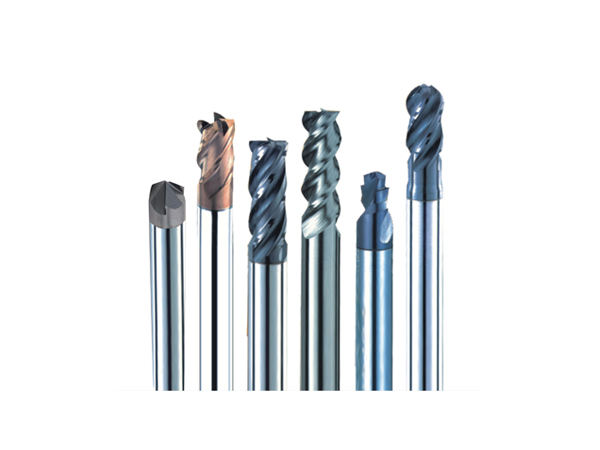When choosing milling tools, multiple aspects should be considered, and the following are specific selection methods:
1. According to the processing materials
1. Steel parts: For steel parts with generally low hardness, such as low carbon steel and medium carbon steel, high-speed steel milling cutters can be used, which have good toughness, sharp cutting edges, can perform cutting processing well, and have relatively low costs. For steel parts with higher hardness, such as high carbon steel and alloy steel, hard alloy milling cutters should be selected. They have higher hardness, wear resistance, and heat resistance, and can withstand higher cutting temperatures and pressures, ensuring machining quality and tool life.
2. Cast iron parts: Due to the high hardness and brittleness of cast iron materials, it is easy to produce chips during processing, so tungsten cobalt hard alloy milling cutters are suitable for use. This type of tool has good wear resistance and impact resistance, and can effectively cut cast iron parts while reducing tool wear and damage.
3. Nonferrous metals: such as aluminum, copper and other non-ferrous metals, have lower hardness and lower cutting force, but require higher surface quality for processing. Diamond or PCD cutting tools can be used, which have extremely high hardness and wear resistance, and can achieve high-precision and high-efficiency cutting processing, obtaining good surface quality. In addition, coated cutting tools, such as those containing aluminum, titanium, and other elements, can also be used to improve the hardness and lubricity of the tool, reduce friction between the tool and the workpiece, lower cutting forces and cutting temperatures, and improve machining efficiency and surface quality.
2. According to the processing technology
1. Rough machining: The main purpose of rough machining is to quickly remove a large amount of material and improve processing efficiency. Large diameter and high feed rate milling cutters, such as reversible milling cutters, should be selected. Inverted milling cutters have multiple replaceable blades, which can complete cutting of multiple cutting edges in one clamping, reducing the number of tool changes and improving machining efficiency. Meanwhile, the inserts of reversible milling cutters are usually made of hard alloy materials, which have high hardness and wear resistance, and can withstand large cutting forces.
2. Precision machining: The requirement for precision machining is to achieve high machining accuracy and good surface quality. At this time, high-precision, small-diameter milling cutters such as ball end mills, end mills, etc. should be selected. Ball end milling cutters are suitable for machining curved surfaces and can achieve high-precision machining of complex surfaces through precise programming control. End mills can be used to machine flat surfaces, step surfaces, grooves, etc. Their cutting edges are sharp, ensuring the flatness and smoothness of the machined surface. In addition, the cutting edge of precision machining tools is usually finely ground and polished to reduce the roughness of the cutting edge and lower the roughness value of the machined surface.
3. According to the type of machine tool
1. Machining Center: Machining centers typically use tools with tool holders, such as BT, HSK, and other standard tool holders. These tool holders have high precision, high rigidity, and good interchangeability, ensuring accurate installation and reliable positioning of the tool on the machine tool spindle. Therefore, milling cutters that match the specifications of the tool holder should be selected on the machining center, such as end mills and end mills with corresponding tool holders. Meanwhile, due to the high rotational speed and feed rate of machining centers, it is necessary to choose tools that can adapt to high-speed cutting, such as those made of hard alloy materials and dynamically balanced.
2. Ordinary milling machine: The tool clamping method of ordinary milling machines is relatively simple, usually using straight or tapered shank tools. Straight shank cutting tools are suitable for milling cutters with smaller diameters, and they are easy to clamp and have lower costs. Cone handle cutting tools are suitable for milling cutters with larger diameters and greater cutting forces. Their taper matches the taper of the machine tool spindle, providing better rigidity and positioning accuracy. When machining on a regular milling machine, due to the relatively low speed and feed rate, the high-speed performance requirements for the tool are not high, but the tool needs to have good universality and adaptability to meet different types of machining needs.
4. According to the type of processing
1. Flat machining: End mills are the preferred cutting tools for flat machining, with their cutting edges distributed on the surface and end face of the cylinder, capable of completing large areas of flat machining in one pass, with high efficiency. For larger flat surfaces, large-diameter end mills can be used; For planes with high precision requirements, fine tuned end mills can be used to accurately adjust the height of the cutting edge and ensure the flatness of the machining plane.
2. Groove processing: When processing grooves, different cutting tools can be selected according to the shape and size of the groove. For narrow and deep grooves, a keyway milling cutter can be used, with a circular blade that can cut at the bottom and sides of the groove. For wide grooves, three edge milling cutters or disc milling cutters can be used, which can complete the cutting of both sides and the bottom of the groove in one pass, improving machining efficiency. If the precision requirement for the groove is high, a forming milling cutter can be selected, whose blade shape matches the shape of the groove, and can directly machine grooves that meet the requirements, reducing machining allowance and processing time.
3. Surface machining: Ball end milling cutters are commonly used cutting tools for surface machining, with a spherical blade that can maintain good contact with the surface during the machining process, achieving precise machining of the surface. When processing complex surfaces, it is usually necessary to use a multi axis linkage machining center, coupled with a ball end milling cutter for programming and processing, in order to obtain high-quality curved surfaces. In addition, for some special shaped surfaces such as ellipsoids, paraboloids, etc., specially designed forming milling cutters can also be used for machining to improve machining efficiency and accuracy.
5. Consider the cost and lifespan of cutting tools
1. Tool cost: The prices of milling tools of different types and brands vary greatly. When choosing cutting tools, it is necessary to comprehensively consider the processing cost and processing requirements. For the processing of parts with large batch sizes and low precision requirements, ordinary cutting tools with relatively low prices can be chosen; For high-precision and difficult parts processing, it is necessary to choose tools with better performance and higher prices to ensure processing quality and efficiency, and reduce overall processing costs.
2. Tool life: Tool life directly affects machining efficiency and cost. Generally speaking, the lifespan of hard alloy cutting tools is longer than that of high-speed steel cutting tools, and the lifespan of coated cutting tools is longer than that of uncoated cutting tools. When selecting cutting tools, one should choose tools with longer lifespan based on factors such as processing materials, processing technology, and processing requirements. At the same time, measures such as optimizing cutting parameters and using appropriate cutting fluids can be taken to extend the service life of cutting tools.
When choosing milling tools, it is necessary to comprehensively consider multiple factors such as processing materials, processing technology, machine tool type, processing type, tool cost, and service life, in order to select the most suitable tool, improve processing efficiency, processing quality, and economic benefits.






